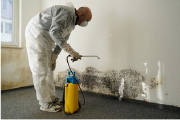 Water damage is a serious issue and time is of the essence when cleaning up a water-damaged area. Leaks indoors can happen due to a plumbing issue such as a burst pipe or faulty seal. Natural causes such as rain or flooding can affect much larger areas. No matter the cause, the aftermath of flooding can include toxic molds such as aspergillus, stachybotrys, and black mold. These and other molds contain dangerous mycotoxins that can make cleanup workers very sick.
Water damage is a serious issue and time is of the essence when cleaning up a water-damaged area. Leaks indoors can happen due to a plumbing issue such as a burst pipe or faulty seal. Natural causes such as rain or flooding can affect much larger areas. No matter the cause, the aftermath of flooding can include toxic molds such as aspergillus, stachybotrys, and black mold. These and other molds contain dangerous mycotoxins that can make cleanup workers very sick.
Cleanup Plan
A clean-up plan involves looking at how to control the source of the moisture. After that, surfaces must be inspected and cleaned or removed. Damaged porous materials such as drywall, insulation, and subflooring should be removed and disposed of properly. Non-porous surfaces such as metal and plastic can be cleaned.
Affected Area Size and Scope
Areas of mold remediation are divided into “small” areas less than thirty square feet and “large” areas between thirty and one hundred square feet. For smaller size cleanups, plastic sheeting and ventilation controls are used to contain the area. For larger areas, the additional use of high-efficiency particulate air (HEPA) filtration masks and air filters, as well as disposable coveralls, is recommended.
Methods to Protect Workers during Mold Cleanup
Working to clean up mold is a hazardous job. Using a multi-pronged approach of engineering controls, work practices, and PPE reduces the risk of worker illness from exposure to mold mycotoxins. Keep in mind that the main route of mold into the body is through inhalation.
MOLD CLEANUP IS VERY DANGEROUS…TAKE IT SERIOUSLY!
Download flyer: STOTW_1202_Mold_Dangers_During_Flood_Cleanup Download Spanish flyer: STOTW_1202_Mold_Dangers_During_Flood_Cleanup_esp

